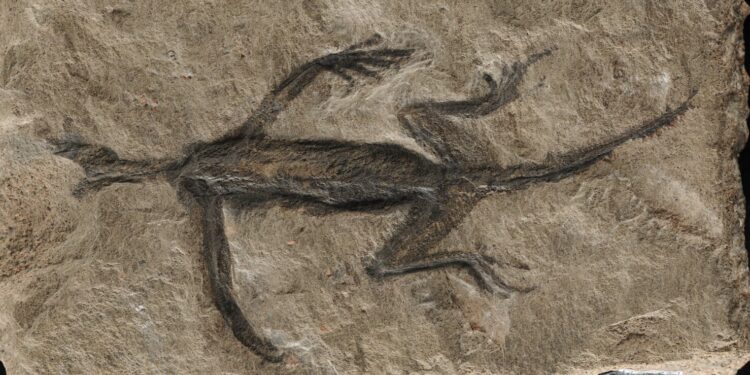Tridentinosaurus antiquus was discovered in the Italian Alps in 1931 and was considered an important specimen for understanding the early evolution of reptiles, but it now turns out to be partly a fake. The outlines of its body, appearing dark against the surrounding rock, were initially interpreted as preserved soft tissue, but it is now known to be painted. Credit: Dr Valentina Rossi
A 280 million-year-old fossil that has baffled researchers for decades has been revealed to be, in part, a fake, following a new examination of the remains.
This discovery led the team, led by Dr Valentina Rossi from University College Cork, Ireland (UCC), to urge caution in how the fossil is used in future research.
Tridentinosaurus antiquus was discovered in the Italian Alps in 1931 and was considered an important specimen for understanding the early evolution of reptiles. The outlines of its body, appearing dark against the surrounding rock, were initially interpreted as preserved soft tissue. This led to its classification as a member of the Protorosauria group of reptiles.
However, this new research, published in the journal Paleontologyreveals that the fossil known for its remarkable preservation is largely just black paint on a rock surface carved into the shape of a lizard.
The so-called fossilized skin had been celebrated in articles and books but had never been studied in detail. The somewhat strange preservation of the fossil had left many experts uncertain about the group of reptiles to which this strange lizard-like animal belonged, and more generally about its geological history.
Dr. Valentina Rossi with an image of Tridentinosaurus antiquus. The fossil, discovered in the Italian Alps in 1931, was considered an important specimen for understanding the early evolution of reptiles, but it now turns out to be partly a fake. The outlines of its body, appearing dark against the surrounding rock, were initially interpreted as preserved soft tissue, but are now known to be paint. Credit: Zixiao Yang
Dr Rossi, from UCC’s School of Biological, Earth and Environmental Sciences, said: “Fossil soft tissues are rare, but when found in a fossil they can reveal important biological information, e.g. example external coloration, internal anatomy and physiology. The answer to all our questions was right in front of us; “We had to study this fossil specimen in detail to reveal its secrets, even those we might not want to know.”
Microscopic analysis showed that the texture and composition of the material did not match that of real fossilized soft tissues.
A preliminary investigation using UV photography revealed that the entire specimen had been treated with some sort of coating material. Coating fossils with varnishes and/or lacquers was the norm in the past and is sometimes still necessary to preserve a fossil specimen in museum cabinets and exhibits. The team hoped that beneath the covering layer, the original soft tissues were still in good condition to extract meaningful paleobiological information.
The results indicate that the body contours of Tridentinosaurus antiquus were artificially created, likely to enhance the fossil’s appearance. This deception has misled previous researchers, and caution is now advised when using this specimen in future studies.
The team behind this research includes contributors based in Italy at the University of Padua, the South Tyrolean Nature Museum and the Museo delle Scienze in Trento.
Co-author Professor Evelyn Kustatscher, coordinator of the Living with the Supervolcano project, said: “The special preservation of Tridentinosaurus has intrigued experts for decades. “
However, all is not lost and the fossil is not completely false. The bones of the hind limbs, particularly the femurs, appear authentic, although poorly preserved. Additionally, the new analyzes showed the presence of tiny bony scales called osteoderms – like crocodile scales – on what may have been the animal’s back.
This study is an example of how modern analytical paleontology and rigorous scientific methods can solve an almost century-old paleontological enigma.
More information:
Forged soft tissues revealed in oldest fossil reptile from the early Permian of the Alps, Paleontology (2024). DOI: 10.1111/pala.12690
Provided by University College Cork
Quote: Paleontological analysis shows renowned fossil believed to show soft tissue preservation is actually just paint (February 16, 2024) retrieved February 17, 2024 from
This document is subject to copyright. Apart from fair use for private study or research purposes, no part may be reproduced without written permission. The content is provided for information only.



